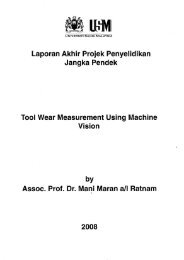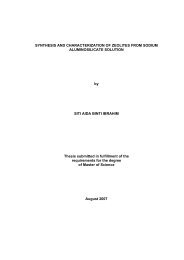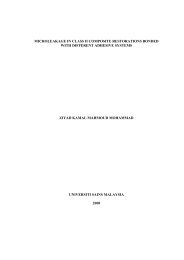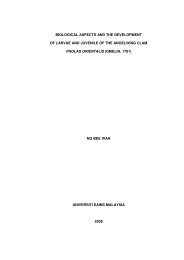a study on the performance of limestone roughing filter - ePrints@USM
a study on the performance of limestone roughing filter - ePrints@USM
a study on the performance of limestone roughing filter - ePrints@USM
Create successful ePaper yourself
Turn your PDF publications into a flip-book with our unique Google optimized e-Paper software.
Water treatment plants have successfully used sand filtrati<strong>on</strong> for many years. In<br />
general <strong>the</strong>re are two types <strong>of</strong> <strong>filter</strong>s which are known as slow sand <strong>filter</strong>s and rapid<br />
sand <strong>filter</strong>s. Slow sand <strong>filter</strong>s c<strong>on</strong>sist <strong>of</strong> a layer <strong>of</strong> sand bed <strong>of</strong> 0.6-0.9 m depth (0.15 to<br />
1 mm diameter) supported <strong>on</strong> <strong>the</strong> bed <strong>of</strong> gravel 0.3-0.45m thick, (through which water<br />
is <strong>filter</strong>ed at low flow rates (Graham, 1988; Sastry et al., 1996). Filtrati<strong>on</strong> rates are as<br />
much as fifty times slower than those <strong>of</strong> rapid sand <strong>filter</strong>s; c<strong>on</strong>sequently slow sand<br />
<strong>filter</strong>s require significantly more surface area in order to <strong>filter</strong> comparable volumes <strong>of</strong><br />
water (Clark, 1997). Rapid sand <strong>filter</strong>s c<strong>on</strong>sist <strong>of</strong> a layer <strong>of</strong> coarse sand 0.6 to 0.75 m<br />
thick (0.5 to 2 mm diameter) laid <strong>on</strong> <strong>the</strong> top, with a layer <strong>of</strong> graded gravel <strong>of</strong> 0.45 m<br />
thick below (Graham, 1988; Sastry et al., 1996).<br />
Slow Sand Filtrati<strong>on</strong> (SSF) is comm<strong>on</strong>ly used as an appropriate water treatment<br />
process and more suitable for developing countries. This method could significantly<br />
improve <strong>the</strong> physical and bacteriological qualities <strong>of</strong> water without <strong>the</strong> use <strong>of</strong> any<br />
chemicals. However, <strong>the</strong> <strong>filter</strong>s are frequently blocked due to <strong>the</strong> accumulati<strong>on</strong> <strong>of</strong><br />
suspended solids and had caused unacceptable short <strong>filter</strong> runs. For SSF,<br />
pretreatment <strong>of</strong> <strong>the</strong> raw water is almost a necessity if <strong>the</strong> raw water has a turbidity <strong>of</strong><br />
more than 50 NTU for period l<strong>on</strong>ger than a few weeks. Roughing <strong>filter</strong>s are <strong>of</strong>ten used<br />
for pretreatment because <strong>of</strong> <strong>the</strong>ir effectiveness in removing suspended solids (Burch<br />
and Thomas, 1998).<br />
O<strong>the</strong>r types <strong>of</strong> <strong>filter</strong>s have been used to meet raw water qualities at a<br />
pretreatment stage. Intake and dynamic <strong>filter</strong>s are <strong>of</strong>ten applied as pretreatment before<br />
slow sand <strong>filter</strong>s. These <strong>filter</strong>s are usually cleaned hydraulically by fast <strong>filter</strong> drainage.<br />
Sequences <strong>of</strong> different prefiltrati<strong>on</strong> stages are frequently <strong>the</strong> most cost-effective opti<strong>on</strong><br />
by applying <strong>the</strong> multi-barrier c<strong>on</strong>cept and, hence, providing an efficient way <strong>of</strong><br />
improving <strong>the</strong> microbiological water quality (Wegelin, 1996).<br />
6

















